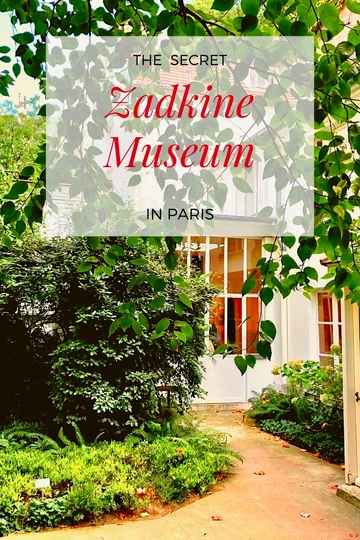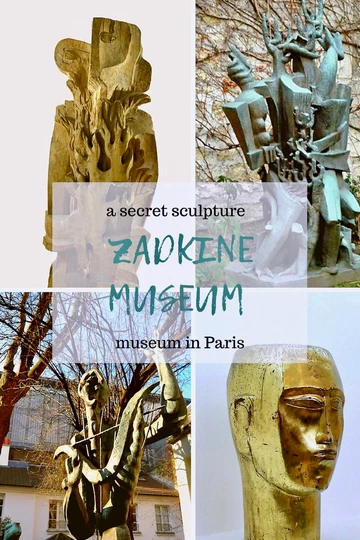Here’s my guide to visiting the secret Zadkine Museum in Paris’ Montparnasse neighborhood.
It’s one of Paris’ best small museums, especially if you admire sculpture. For sculpture, it’s second only to the Rodin Museum.
The Zadkine Museum is a hidden gem in Paris. It’s largely tourist free and conveniently located right next to the verdant Luxembourg Gardens, which also boasts a riveting outdoor sculpture display.
I had just arrived in Paris for a longish geographical cure with a childhood friend based abroad.
Our first order of business was lunch and a stroll in the beautiful and serene Luxembourg Gardens. Over crusty warm bread and brie, we caught up on important personal matters, commiserated over demoralizing life events, and fondly reminisced about past travel adventures.
Apart from the good food and good conversation, we had also come to inspect what is essentially a peaceful, uncrowded outdoor sculpture museum. Or an homage to 19th century French cultural history. Amid the lush flower gardens, there are over 100 statues, monuments, and fountains in Luxembourg Gardens.
The sun-speckled gardens feature heavily in Victor Hugo’s romantic novel Les Miserables and were frequented by the real life Jean-Paul Sartre and Simone de Beauvoir. With that romantic backdrop, it felt quite natural to let the shackles of “real life” drop away and be transported to a past century.
We strolled past a bust of Eugene Delacroix, the father of the Romantic period of painting whose Liberty Leading the People causes queues at the Louvre. We admired a marble statue of the novelist George Sand and the nearby stele of the novelist Stendahl by Auguste Rodin.
We loved Antoine Bourdelle’ Bust of Beethoven, with its tormented visage and shock of hair. And then there is the classic The Mask Seller by Zacharie Astruc, a bronze depicting a boy holding a mask of Victor Hugo.
But we were perhaps most captivated by Homage to Paul Eluard by Ossip Zadkine, which is hidden in the western corner of the Luxembourg gardens.
The sculpture is somewhat reminiscent of Zadkine’s career defining work, The Destroyed City, in Rotterdam. It is more surreal than cubist, appropriate for honoring Eluard, one of the founding fathers of Surrealism.
Conversation turned to the mobification of Paris’ major museums. In my recent visits, the major museums — the Louvre, the Musee d’Orsay, the Pompidou Center — had been crammed to the gills with tourists. Even the smaller Picasso Museum required pre-purchased tickets and had a long queue to enter.
On my last trip, I had pre-purchased tickets to a rare “must see” Johannes Vermeer exhibit at the Louvre. I was in a queue for nearly 2 hours just to enter the exhibition at my designated time. There were masses of people bunched in front of each small Vermeer painting.
It was a madhouse. I felt claustrophobic, and did not linger long, forgoing any real appreciation of Vermeer in favor of escaping.
This is all very discouraging.
Who wants a cultural escape to be akin to a packed metro or boisterous beer hall? Aren’t museums supposed to be soothing and contemplative affairs? Or at least somewhat swoonful?
In response, and to safeguard the quality of my geographical cures, I had taken to frequenting Paris’ more obscure small museums — the Musée Marmottan Monet, the Musée Jacquemart-André, the Musée d’Art Moderne, the Musée National Gustave Moreau, the Musée de la vie Romantique, and the Delacroix Museum.
Overview of Paris’ Secret Zadkine Museum
Pointing to the Zadkine sculpture, which we were still admiring, my friend said, “Well, there’s a Zadkine Museum nearby.” I didn’t need any convincing.
Two short blocks from the Luxembourg Gardens in the heart of Montparnasse lies the secret Zadkine Museum. You can blink and miss it, it’s so well hidden.
Located at 100 bis Rue d’Assas, it is situated behind an industrial building that seems inconsistent with anything artistic. But just to the left is a small, seemingly private driveway. If you follow it, you arrive at the Zadkine Museum. Voila.
The intimate museum occupies the first floor of a two story house and has an impressive sculptural garden. It was formerly Zadkine’s home and studio, where he lived for 40 years.
The museum and its entire collection were donated to Paris by Zadkine’s widow, Valentina Prax, after her death in 1982. It was extensively renovated to better showcase the artwork and re-opened in 2012.
Ossip Zadkine, The Artist
Ossip Zadkine was born in Vitebsk in Belarus, then part of the Russian Empire, in 1888. He moved to Paris around 1909 and settled in the Montparnasse area, hoping to have more freedom of expression and exposure to new artistic theories.
Initially, Zadkine studied at the Ecole des Beaux Artes, but was quickly dissatisfied. He became associated with the School of Paris, a group of avant garde foreign artists residing in Paris.
But he was essentially a free spirit, not connected to any specific movement. He was influenced by primitivism, cubism, futurism, expressionism, and classicism. And he loved Rodin.
Zadkine’s works were first exhibited in 1911. He presented statues and drawings at the annual Salon d’Automne and at the Salon des Indépendants, mostly influenced by Cubism.
In 1928, he moved to Rue d’Assas, an “oasis,” which provided him with inspiration for decades.
The Gardens of the Zadkine Museum
The Zadkine Museum garden is indeed an serene oasis. It is planted with hollies, hawthorne bushes, vines, hydrangea, and other flowers. And strategically set among them are large life size bronze sculptures.
The most famous is perhaps Zadkine’s Torso of Ruined City, a smaller scale version of his famous The Destroyed City in Rotterdam.
It is typical of his expressionistic phase when Zadkine claimed: “Emotion! Humanity! …The object created by the sculpture must arouse emotion in the onlooker.”
The Destroyed City, commemorates Rotterdam’s devastation from Nazi bombers in WWII. The sculpture reflects the height of his artistic expression.
It hints at cubism, but really veers more into expressionism with a twisting torso, arms akimbo, and a pierced hole where a heart should be. The artist described the sculpture as “a cry of horror against the inhuman brutality of this act of tyranny.”
In stark juxtaposition to the garden’s expressionistic Torso of a Ruined City is Zadkine’s earlier more primitive urn carrying Rebecca.
Based on archaic forms, Rebecca has the posture of a caryotid, but with a simplified form. Zadkine said that she “retains the heady perfume of the forest.”
In the gardens you will also find Zadkine’s majestic Orpheus from 1956. In Greek mythology, Orpheus was a legendary musician who went to the underworld to rescue his wife Eurydice. He wasn’t supposed to look at her until they were out of Hades, but he did, and she vanished for good.
Guide To The Zadkine Museum: What To See
Entering the museum, you’ll find a procession of small well-lit rooms with glass ceilings and white walls. The museum presents all periods of Zadkine’s work in roughly chronological order.
It traces the “primitivism” of his first sculptures carefully carved in wood or stone, to the strict geometry of his Cubist works, to his more expressionistic works, and finally to the pared down neoclassicism of his final years.
Zadkine’s work has an endless freedom and vitality to it. He worked in many mediums — stone, wood, plaster, cement, marble — and his themes were musical, mythological, and religious.
Highlights of the museum’s collection include his wooden sculpture of Prometheus, carved from a 9 foot tree trunk, Hermaphrodite, and L’Oiseau D’or.
The Promestheus sculpture (shown below) is:
“one of the very last large wood sculptures produced by Zadkine. It was carved in a block of elm wood, – a species which Zadkine particularly liked and which today has almost disappeared. The thickness of the log is evident in the carving of its bulk, and textural effects are obtained through the visible traces of tools: straight, semi-flat and hollow gouges, and hatchet.”
I really liked the playfulness of The Golden Bird, or L’Oiseau D’or. In it, plaster is covered with gold leaf. It is, of course, reminiscent of Constantin Brancusi.
In the last room is Zadkine’s Project for the Monument to the Van Gogh Brothers. The final work stands on Van Gogh Square in the town of Zundert in the Netherlands.
The sculpture is in the style of The Destroyed City. It shows the two brothers, Vincent and Theo, intertwined and dependent on each other. They are buried together in Auvers-Sur-Oise France outside Paris. I’ve written about Van Gogh’s life in Auvers and whether he really committed suicide.
In sum, don’t miss the Zadkine Museum when you’re in Paris. It’s a lovely house-studio-museum-garden.
It’s a hidden gem in Montparnasse in a calm and beautiful setting. There’ll be no crowds, and you can enjoy the sculpture and the gardens without being jostled or bumped. You might even begin in the lovely Luxembourg Gardens.
Practical Guide & Tips For Visiting the Zadkine Museum:
Address: 100 bis rue d’Assas 6th a
Hours: Tuesday to Sunday, from 10:00 am to 6:00 pm, closed Mondays and holidays.
Entry: € 7
Metro: Vavin or Notre-Dame des Champs
You may enjoy these other Paris travel guides and resources:
- 3 day itinerary for Paris
- 3 day art weekend in Paris
- 5 day itinerary for Paris
- Hidden gems in Paris
- Best churches in Paris
- Guide to the Latin Quarter
- Guide to Montmartre
- Best museums in Paris
- Monet guide to Paris
- Louvre survival Tips
If you’d like to visit one of Paris’ secret museums, pin it for later.


